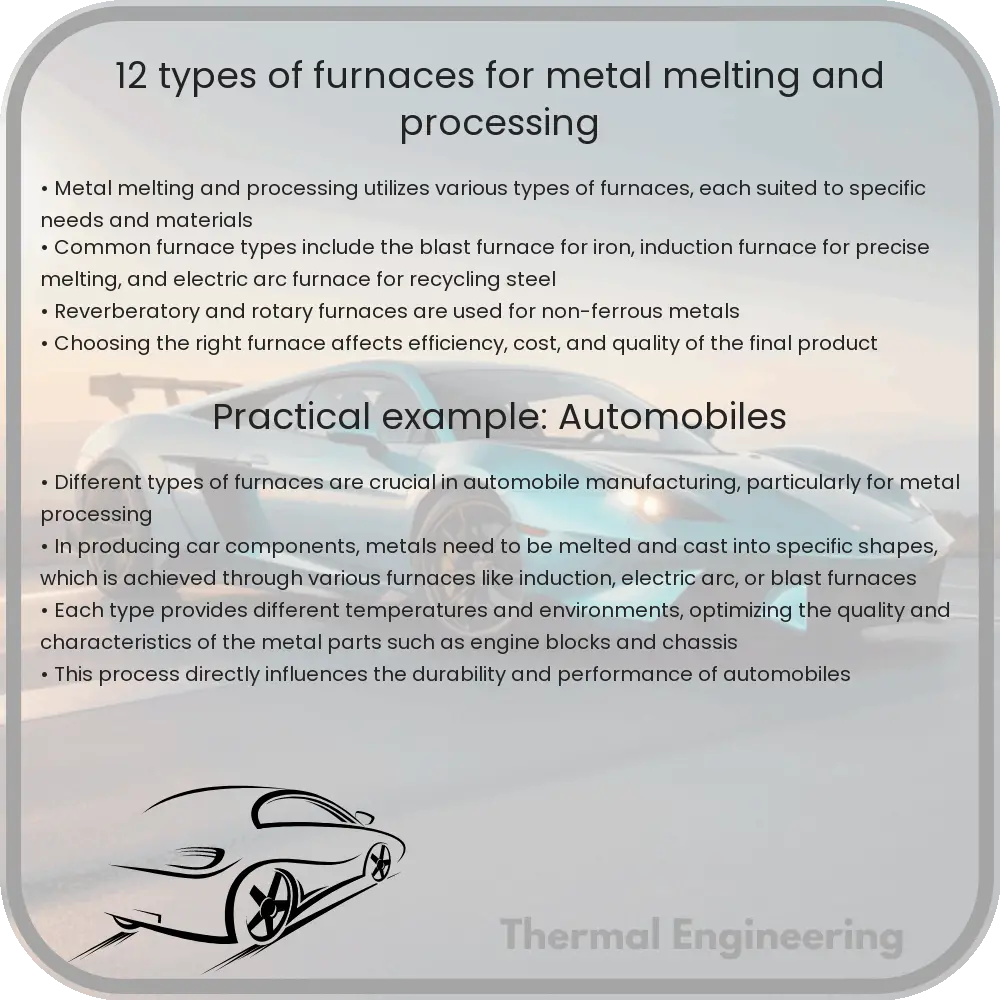Learn about the various furnaces used for metal melting and processing, including their uses and benefits.

Introduction to Furnaces for Metal Melting and Processing
Metal melting and processing is a fundamental aspect of materials engineering that involves the conversion of solid metal into a liquid form. The process requires high temperatures that are achieved through various types of furnaces. Each type of furnace is designed to meet specific industrial needs, considering factors such as the type of metal, melting temperature, production volume, and energy efficiency. Below, we explore 12 common types of furnaces used in metal melting and processing.
Types of Furnaces
1. Cupola Furnace
A traditional furnace used primarily for casting iron. It operates on the principle of counter-current heat exchange, using coke as the fuel. Metal and coke are added in batches to the top, and air is blown into the base to stimulate combustion.
2. Electric Arc Furnace (EAF)
Popular in steel-making, an EAF uses high-voltage electric arcs between charged electrodes to melt the metal. This type is known for its ability to recycle scrap steel by melting it down repeatedly.
3. Induction Furnace
Utilizes electromagnetic induction to heat metal, leading to rapid melting with high energy efficiency. Induction furnaces are ideal for melting high-quality steel and non-ferrous metals because they minimize contamination.
4. Blast Furnace
Largely used for iron production, this massive structure extracts iron from iron ore. The furnace operates with a continuous infusion of iron ore, coke, and limestone. The hot air blast is directed into the bottom to facilitate the chemical reactions needed to separate the iron.
5. Reverberatory Furnace
In this furnace, the fuel is burnt in one part of the furnace, with the flames directed over the metal (usually aluminum or copper), thus avoiding direct contact with the fuel. This method helps in preventing contamination of the metal.
6. Rotary Furnace
As the name suggests, these furnaces rotate during operation, improving the mix and exposure of scrap metals to heat. Rotary furnaces can be designed to work with various fuel types and are commonly used in the recovery of non-ferrous metals.
7. Crucible Furnace
This is one of the most basic forms of a melting furnace, using an insulated crucible to hold and melt the metal. Heat is applied from an external source and can be controlled quite accurately.
8. Vacuum Furnace
Used predominantly for high-quality metal alloys and ceramic materials, the vacuum furnace removes the presence of air and any potential contaminants during processing, providing exceptional product purity.
9. Submerged Arc Furnace
This furnace is used primarily for the production of ferroalloy, silico manganese, and calcium carbide. It operates with electrodes that are submerged into the raw materials, creating arcs that facilitate melting.
10. Pusher Furnace
Typically used for continuous processing, a pusher furnace systematically pushes metal through the furnace on wheeled racks, ensuring consistent treatment over long production periods.
11. Walking Beam Furnace
Primarily seen in steel mills, the walking beam furnace heats metal stock continuously. Its unique design allows the heated metal to ‘walk’ through the furnace on mechanically operated beams, achieving uniform heating necessary for further processing.
12. Solar Furnace
Making use of solar energy, this furnace focuses the sun’s rays to a single point to generate extremely high temperatures. While not widely used in industrial metal processing, solar furnaces represent a growing interest in sustainable manufacturing technologies.
Conclusion
Understanding the different types of furnaces used in metal melting and processing is crucial for selecting the right furnace for the job. Each type offers specific benefits and is suited for particular metals and production scales. By choosing the appropriate furnace, manufacturers can optimize their production efficiency, reduce costs, and maintain product quality.